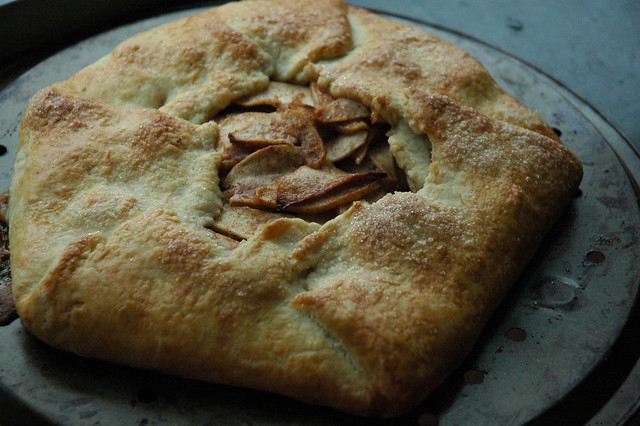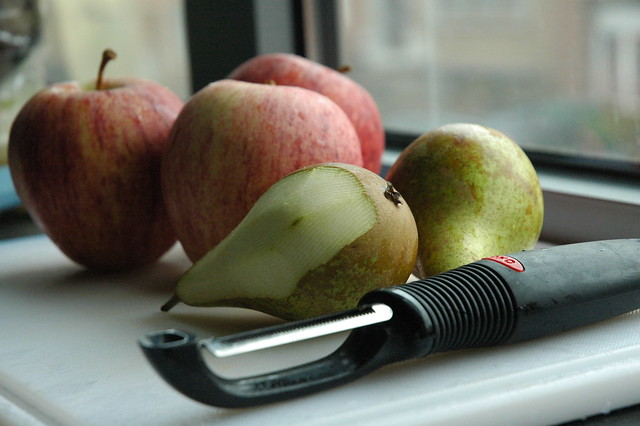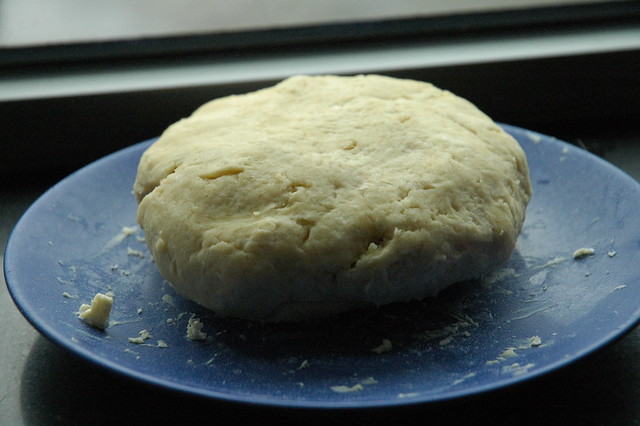A freshly baked apple and pear galette.
Apples and pears
Galette dough
What is a galette? I've made several galette pies in the past year and to me they are a simple rustic way of making a pie with savory or sweet fillings. The galette dough uses the same techniques as making pie dough but there is no fluting or rolling in between wax or plastic papers. Even better, it doesn't need a pie plate or other baking pan to be set in. I've baked it on the back of a baking sheet, and a pizza stone. It's simple, straightforward, and it's lazy, which are words that I can get behind when baking.
I picked the pears while on a bike ride, but the apples and pears should be in season so this is certainly a pie to welcome autumn. The best compliment I got for this apple pear galette was that it was delicious because it wasn't cloyingly sweet. To me that is a compliment: fruit pie that tastes more like fruit and less like sugar.
Now if you want the recipe just skip down the next few paragraphs until the end. But perhaps you know me well enough and will agree:
I've decided I'm (going to try) avoiding all pre-packaged and prepared sweets and dessert-like foods that were not prepared at home. I mostly do this with foods that I cook (I make exceptions for things like canned beans and tomatoes). I am not a health freak, but my reasons probably have a health/nutrition basis. In a nearby grocery store, I can find mixes for all the items that I can bake, but I can't find half of the raw ingredients. Why? The baking aisle is 3/4 filled with packaged pre-prepared baking kits, and other ready-made baking goods, but actually contains 1/4 of raw ingredients. It's kind of the same exact trend with home-cooked foods, right? The grocery store is filled with ready-made, pre-packaged, heat and eat meals - all marketed and placed strategically for you to take home, and yet the raw goods just sit there waiting to make it into your basket. Every aisle that actually contains raw foods, is outcompeted by ready-to-eat junk. By raw ingredients I mean minimally processed real foods. Any food that has to make a claim to it's healthiness on the front of package needs to be thrown in the trash. It pisses me off that there are entire aisles dedicated to junk foods and sodas. My local grocery store can stock an entire aisle of sodas, but can't carry one brand of almond paste? Has one brand of baking soda? Has one brand of whole wheat flour? Contains two types of raw oatmeal (e.g. the sole ingredient is listed as oatmeal) in the cereal aisle that has hundreds of processed sugary cereals that sit right along with it (the oatmeal is cleverly placed on the bottom aisle)? Contains two types of plain yogurt, and has the next 2 meters dedicated to sugary probiotic processed yogurts all making the same health claims?
While government and industry hash it out, actions that I can take on the local-consumer level are actively avoiding purchasing the crap products, and asking the grocery stores to carry more raw ingredients, and purchasing from stores and sellers that do carry healthier items. Grocery stores should get behind national nutrition guidelines, promoting and selling healthier foods, and making the choices easier. The easy part for me is to blame the food industries with their endless budgets for food research and development, but they are selling their products, are actively trying to locate food trends to hook new customers, and are actually selling their foods that line the shelves of grocery-store aisles. While I have, and will probably continue to use many convenience items (breakfast cereal, ready-made pie dough, bread, frozen pizzas), I do not think that convenience items should replace raw ingredients. Take a look around your grocery store. It is alarming how many foods have been replaced, or outcompeted.
End of rant. Hello Monday. Hello leftover apple pear galette. Now, ready to make some pie dough from scratch (flour, sugar, salt, butter, water)?
Galette pie dough
Yield: 1, 13-14" galette pie crust adapted from Deborah Madison's Vegetarian Cooking for Everyone.
2 cups all-purpose flour (whole-wheat pastry flour is fine)
1/2 teaspoon salt
1 tbsp sugar
10-12 tbsp butter
1/2 cup ice water (you will probably not use all of it)
Basically, pie dough is fairly easy to make, but you need patience and practice. You need very cold butter, ice water, and flour with low amounts of gluten. Fat adds flavor and flakiness, the water brings everything together and helps the flour attach to the butter globules (contributing to flakiness). The water also helps to keep the butter cold so that you get a crust with flakiness. You want to avoid whole-wheat flour because it has too much gluten and will create a stretchy dough - which is ok for bread, but not good for pie crusts. We'll prep the butter first, then we'll let it chill in the freezer for a few minutes while we get the flour ready. Then we'll add cold butter to the flour, and cut it in, and finally water is added last to begin the assemblage of flour/butter crumbs to a rollable dough.
Directions:
- Dice up the butter into small chunks. I have used 7 tbsp to the full 12 tbsp; I find a mixture in between is sufficient. If you use all-purpose flour you will need less butter (around 9 tbsp); if you use whole-wheat pastry flour, or a mixture of whole-wheat pastry with all-purpose, you will need more butter (around 10-12 tbsp). I like having the max amount ready because you can always store the un-used butter. Place the small diced chunks of butter on a plate and pop them in the freezer. 10 minutes should suffice.
- In a large mixing bowl, stir together 2 cups of all-purpose flour, salt, and sugar.
- Fill a 1 cup measuring cup with ice cubes. Fill the cup half-way, let stand 1 minute.
- Remove the butter from the freezer. In the large mixing bowl, add in 2-3 tbsp of cubed very cold butter, working with a fork or pastry cutter, cut in the butter. The cold plate helps keep remaining butter cold. Add in 2-3 tbsp more (repeat as needed) and continue. If doing by hand it will take you up to 10 minutes to work the flour until it has pea-sized chunks and looks coarse and mealy. Use patience, and take your time. I use a fork, and just push the fork into the butter/flour mixture with my thumb.
- Once the mixture has good pea-sized chunks, add in 1-2 tbsp of water at a time and using your hands begin to mix everything together. The dough should begin to come together. It is better to have a drier dough than a wet dough, so if some of the dough does not form into the ball, just add in drops of water and press into the bowl. You'll get the ball to come together. Flatten the ball into a disc, place it on a plate, and store in the fridge until ready to use. Now, prep the apple filling while the dough rests.
Apple and pear filling
3 to 4 cups apple and pear slices, peeled and sliced thin (use a tart apple, or a variety of tart apples, usually from 4-5 medium/large fruits)
juice of 1/2 of a lemon (lime is fine too)
1/2 cup sugar
2 tbsp brown sugar
1/4 cup flour
pinch salt
1 and 1/2 tsp cinnamon
1/8 tsp nutmeg
2 tbsp amaretto, or sweet wine
Egg wash (optional)
1 egg white
1 tbsp milk
1 tbsp sugar for sprinkling
Directions:
- Set peeled and sliced fruit in a large bowl. Squeeze 1/2 of a lemon to prevent the slices from turning brown.
- In another bowl, add sugars, cinnamon, flour, salt, and nutmeg. Stir to combine.
- In a sifter, sift the flour and spice mixture over the sliced fruit. Turn the fruit slices to coat everything.
- Stir in amaretto or sweet wine. Avoid overmixing.
- Combine egg white and milk, stir together and set aside. The egg wash will be brushed on last as a glaze, or a sheen, to the un-baked pie. Sugar can be sprinkled on top of the egg wash to give it a nice finish. This step can be omitted.
- Bake the galette at 400º F for 40 minutes or until the top is golden. Place another sheet below to catch any drippings.
Now putting it all together:





Nilam,
ReplyDeleteWe went pear picking in Hood River last weekend, your inspiration is well timed :)
Add Amaretto & lemon juice to the filling? My kind of pie!
--nico
YES! YES! YES!
ReplyDelete